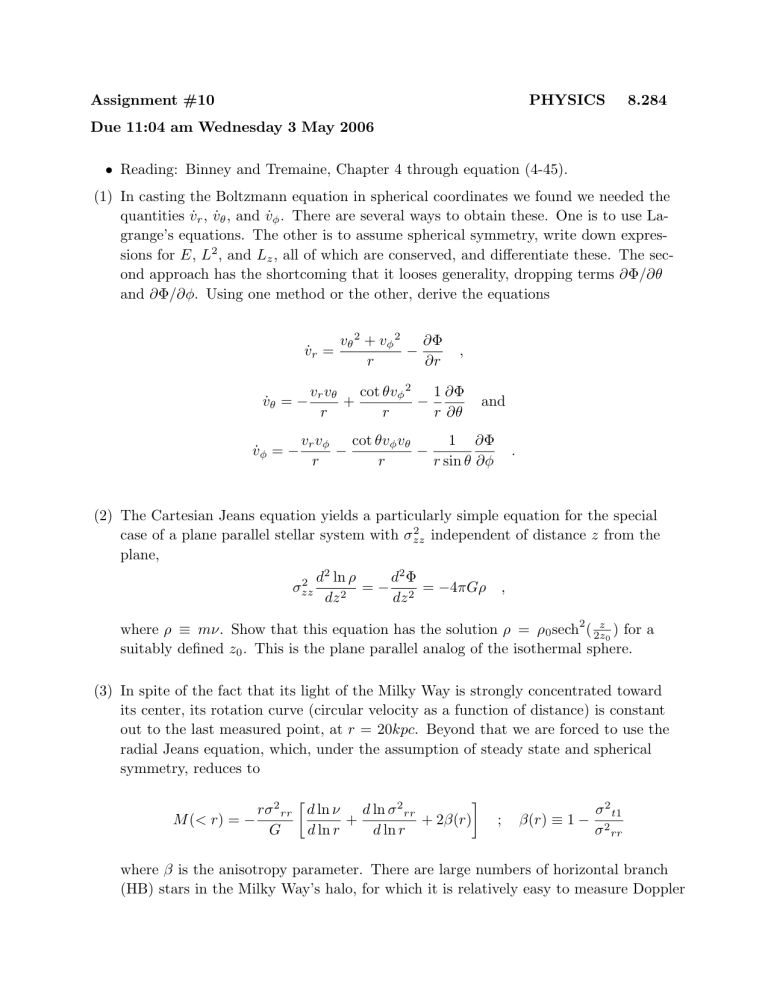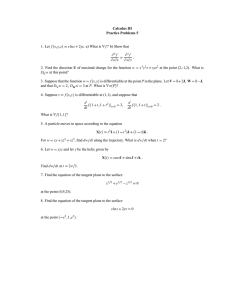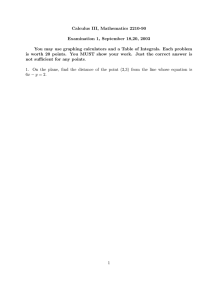Assignment #10 PHYSICS 8.284 Due 11:04 am Wednesday 3 May 2006

Assignment #10
Due 11:04 am Wednesday 3 May 2006
PHYSICS 8.284
• Reading: Binney and Tremaine, Chapter 4 through equation (4-45).
(1) In casting the Boltzmann equation in spherical coordinates we found we needed the quantities ˙ r
, v ˙
�
, and v ˙
�
.
There are several ways to obtain these.
One is to use Lagrange’s equations.
The other is to assume spherical symmetry, write down expres sions for E , L 2 , and L z
, all of which are conserved, and differentiate these.
The sec ond approach has the shortcoming that it looses generality, dropping terms ρ � /ρν and ρ � /ρπ .
Using one method or the other, derive the equations v r
= v
�
2 + v
�
2 ρ � r
−
ρr
, v
�
= − v r v r
�
+ cot νv
�
2 r
−
1 ρ � r ρν and v
�
= − v r v
� r
− cot νv
� v
� r
1 ρ �
− r sin ν ρπ
.
(2) The Cartesian Jeans equation yields a particularly simple equation for the special case of a plane parallel stellar system with θ 2 zz plane, independent of distance z from the
θ
2 zz d 2 ln β dz 2
= − d 2 dz
�
2
= − 4 �Gβ , where β � m� .
Show that this equation has the solution β = β
0 sech
2
( z
2 z
0
) for suitably defined z
0
.
This is the plane parallel analog of the isothermal sphere.
a
(3) In spite of the fact that its light of the Milky Way is strongly concentrated toward its center, its rotation curve (circular velocity as a function of distance) is constant out to the last measured point, at r = 20 kpc .
Beyond that we are forced to use the radial Jeans equation, which, under the assumption of steady state and spherical symmetry, reduces to
M ( < r ) = − rθ 2 rr
G d ln � d ln θ
+ d ln r
2 rr d ln r
�
+ 2 � ( r ) ; � ( r ) � 1 −
θ 2 t 1
θ 2 rr where � is the anisotropy parameter.
There are large numbers of horizontal branch
(HB) stars in the Milky Way’s halo, for which it is relatively easy to measure Doppler
velocities.
Since we’re much closer to the galactic center than they are to first order we are measuring their radial velocities.
Suppose one measured 100 such stars at r = 40 kpc and found θ 2 rr
= 110 km/s.
Suppose further that the density � of
HB stars falls off as r
−
3 , and that θ 2 rr is independent of radius.
Calculate the mass of the Milky way a) on the assumption that the orbits are strictly radial and b) on the assumption that the orbits are isotropic, i.e.
that the velocity dispersion in each tangential direction is equal to that in the radial direction.
(4) Consider a plane parallel explosion which releases an energy per unit area µ in the plane z = 0 at time t = 0.
Suppose that the explosion expands into a cold uniform medium with density β .
a) Using dimensional arguments, determine the power law dependence of distance of the shock from the symmetry as a function of time.
b) Suppose that at some time the shock has a velocity of 1000 km/s, and that the medium into which it is expanding is pure hydrogen.
What it temperature of the gas immediately behind the shock.



